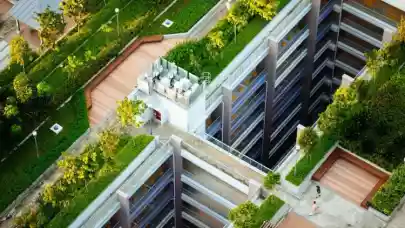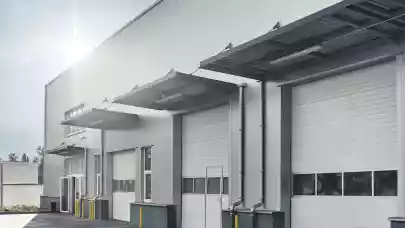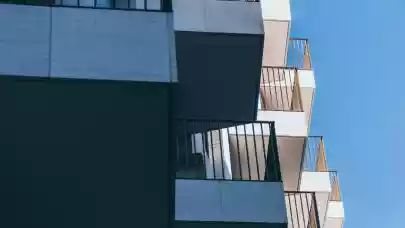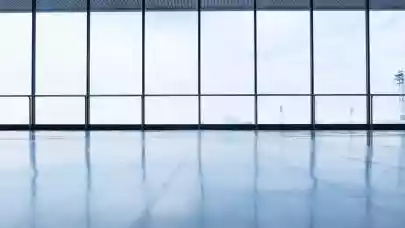
More than three-quarters (76%) of office stock across Europe will be at risk of obsolescence by 2030 according to the latest report from Cushman & Wakefield. One of the reasons is the increased level of legislative action around sustainability requiring investors to modernise real estate to ensure ESG compliance. To take one example, commercial property landlords are required in a growing number of cities across North America and Europe to install green roofs that help increase urban biodiversity, optimise energy costs and improve the user experience.
The need for more greenery in buildings was also highlighted in tenant satisfaction surveys which Cushman & Wakefield recently carried out among users of Warsaw office buildings.
“Office building lobbies were the lowest-rated spaces due to insufficient greenery. It is notable, however, that reception desk areas in many buildings are among the few places where property landlords and managers can successfully ensure the right quantity and diversity of plants. Due to dense urban development, especially in central districts, there is little space left for green, outdoor zones for building users, subsequently affecting the workplace experience and employee well-being. This could be solved by installing green, biodiverse roofs and terraces, a trend that has for years been gaining traction in such countries as Switzerland, the U.S. and Canada”, comments Grzegorz Dyląg, Partner, Head of Asset Services Business Space, Asset Services EMEA, Cushman & Wakefield.
Municipalities and other stakeholders focus on greenery
In 2022 the French Parliament approved a law requiring all new commercial buildings to partially have their roofs covered with plants or solar panels. Although this regulation is less stringent than the initial proposal of French environmental activists who called for complete green coverage, this is a huge step towards more sustainable cities and infrastructure.
France is therefore the first country to introduce such legislation nationwide. Previously, legislation requiring landlords to create biodiverse, green gardens on rooftops was introduced by municipalities. A good example is Basel, where initiatives aiming to increase the provision of green roofs were initially driven by energy-saving programmes and later by biodiversity conservation. The city has promoted green roofs through investment incentive schemes since 1996. In 2002, an amendment to its building laws was passed which mandated green roofing for not only new but also retrofitted buildings with flat roofs.
In Austria, the intense industrialisation of Linz during the 1960s and 70s left the city with few high-quality green areas. A remedy was to be provided by a plan approved in 1984 that mandated the installation of green roofs on industrial and retail buildings. As expected, developers were far from enthusiastic about the new regulations. Therefore, to avoid a crisis situation, in 1989 the city began to hand out direct financial incentives in the form of subsidies covering 30% of the construction cost of any green roof built. These subsidies steadily decreased as the green roof industry stabilised and developers began to accept the new legislation. In addition, subsidies for building a green ‘fifth elevation’ were also introduced by many cities across North America, including Portland, Washington, Illinois, New York, Toronto and Montreal.
Let’s give the city back to nature
According to data from Cushman & Wakefield, approximately 24% of existing European office stock built over the last decade is fit for meeting occupier requirements and is in high demand. 62% needs to be repositioned to avoid slipping into obsolescence and the remaining 14% is ageing, non-updated stock.
“These statistics point to a rather alarming conclusion: 76% of existing office buildings are probably insufficiently aligned with occupier requirements which keep growing. The pandemic has changed our attitude to the workplace, creating a stronger craving for contact with nature and achieving a healthy work-life balance. Furthermore, lockdowns shifted the focus of many towards a more sustainable lifestyle as the impact of increasingly rapid climate change continues to contribute to increased environmental awareness. Unfortunately, many buildings stand against this tide of change. Therefore, property owners have a huge responsibility for their repositioning. Such strategic measures should include expanding green, biodiverse spaces to give the city back to nature at least to some degree”, adds Anna Górska-Kwiatkowska, Head of Leasing Services, Cushman & Wakefield.
Environmental benefits resulting from planting vegetation on building roofs or terraces include mitigation of urban heat islands which occur when an urban area is significantly warmer than its surrounding rural areas due to dense clusters of concrete, asphalt and other surfaces which absorb and release heat. The roofs and other surfaces of commercial buildings covered with a layer of grass, flowers or shrubs take in heat and lower the temperature inside a building and in its surroundings. In addition, green roofs improve air quality by filtering out pollutants and capturing dust and other harmful agents and help reduce rainwater runoff. Any collected rainwater can be later reused.
“Increasing the green area percentage will naturally minimise the environmental footprint of a property and help companies achieve the environmental objectives of their ESG strategies. This is also an area where there is a strong correlation between sustainability and gradual cost optimisation. Although significant financial outlays are required from investors for upgrading and greening building roofs and terraces, such investments will partially pay back. Vegetation provides an additional insulation layer that helps reduce energy costs. It is also worth noting that green roofs have a longer life span than traditional ones,” comments Andrew Frizell, Head of Project & Development Services Poland, Cushman & Wakefield.
Green repositioning
Let us imagine that our employer allows us to choose an office. There are two options in similar locations on the table, but one has additional green infrastructure which we will be able to access, for instance, during lunchtimes. You simply come out onto an outdoor terrace or roof and you are there – in a small urban meadow. Which building would you choose? The answer appears self-evident.
“Buildings that provide biodiverse, green spaces are undoubtedly viewed as more attractive. Therefore, planting vegetation on rooftops should be part of their repositioning strategies. It will translate into greater user comfort and, what’s more, it’s likely to become a key aesthetic differentiator”, says Grzegorz Dyląg.
Many iconic green roofs have been installed worldwide over the years, including on the California Academy of Sciences, one of the world’s largest science museums, Beijing airport and Moesgaard Museum in Aarhus, Denmark. Are similar rooftop installations likely to be built in Poland as well? Decisions made by some Polish cities are setting a promising base. A green roof will be an integral part of Lublin’s Metropolitan Station, which is under construction. In Gdynia, the car park in front of the city town hall will move underground, with an inhabitant-friendly green area to be built above it. Warsaw has demonstrated that even public transport stops can be green – it already has 26 shelters with living roofs. Green roofs have also become an important part of commercial buildings. One building of Warsaw’s Forest office complex features an urban garden. Greenery will also be a strategic element of the recently unveiled Towarowa project of Echo Investment. Meanwhile, STRABAG Real Estate will revive the urban fabric by opening to the public its flagship project Upper One with two new passageways that will feature integrated greenery. The office building will also provide tenants with unique access to close to 400 sq m of terraces on its top floors which can be fully greened. The developer will suggest a recommended vegetation layout but the final outcome will depend on individual tenant preferences.
“A consistent and transparent system of investment incentives would definitely help to spread the concept of green roofs. It would also be useful to develop design requirements and a set of good practices that would support developers in creating biodiverse roofs as additional public spaces. As a result, the centres of large Polish cities are likely to become green enclaves in the coming years”, concludes Grzegorz Dyląg.



